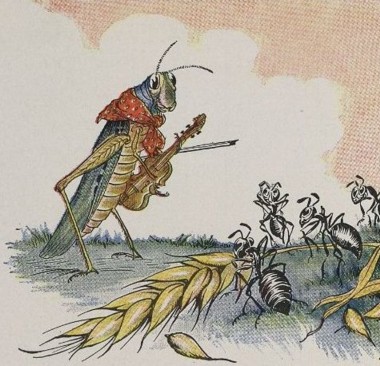Week 4, Reading Notes B: Aesop's Fables (Jacobs)
 |
| The Ant and the Grasshopper on Wikimedia |
The second part of Aesop’s Fables compiled by Jacobs deals with lesser-known fables and/or characters who are used less frequently. These include Insects, People, and Birds. Because I have not read about these characters as much as I have Lions, Wolves, and Foxes, I was excited to read these fables. Just like the tales for Reading A, some of Jacobs’ tales are followed by Crane’s renditions. Crane turned these popular fables into short poems of about five verses each. It is generally easier to understand the context and dialogue of Jacobs’ fables, but I found that occasionally it was clearer to read the morals explicitly expressed at the end of Crane’s. Also, Crane sometimes changes the characters used in the fables, or alters the plot of the fable, but keeps the moral about the same. It is also interesting to read how two similar stories can be interpreted by two different readers/authors, because there are some instances in which the morals themselves vary. This shows that even when dealing with similar plots in a story, two readers can take away completely different meanings.
The Fox and the Crow is a good example of Jacobs and Crane keeping the same title of their tales, as well as similar morals. Both of these fables are short, and the plot is of a Fox convincing a Crow to drop her cheese through flattery. Jacobs’ moral is, “Do not trust flatterers”, while Crane’s is, “Beware of flatterers”.
An example of these two authors taking the same tale and making less identical fables is Jacobs’ The Jay and the Peacock. In this tale, a Jay takes the fallen feathers of a Peacock and wears them. This annoys both the other Jays and the Peacocks, and the moral is, “It is not only fine feathers that make fine birds”. Crane’s version uses a different type of bird, a jackdaw, and a different title, The Vain Jackdaw. The events in Crane’s poem are the same, yet the moral is, “Borrowed plumes are soon discovered”. Where Jacob’s moral seems to be an attack on the Jay’s character, Crane’s is more of a warning that it is necessary to be authentic and to not try to fool others. This same plot has brought about two different takes on the story. This seems to indicate that two readers may easily find different things within the same story, or interpret the same story differently.
Another tale that I liked was The Ant and the Grasshopper. I read this same fable in French last semester in a French poetry and literature course with professor Michael Winston. The tale is of a Grasshopper who would rather sing on a fine day than prepare for the winter. When winter comes and he has no food, he realizes that he should have followed the example of the Ant who was working hard on that fine day. Winston explained that the Ant was like a common worker of the middle class, and the grasshopper was an artist who had to ask others for help. Without Winston’s course, I would never have realized that this fable can be read as a critique on the society of Aesop’s day. You can access these fables here: link.Crane, Walter. “The Baby’s Own Aesop (1908).” The Public Domain Review, Web.
Jacobs, Joseph, et al. Aesop's Fables. Rizzoli, 1991. Web.
Comments
Post a Comment